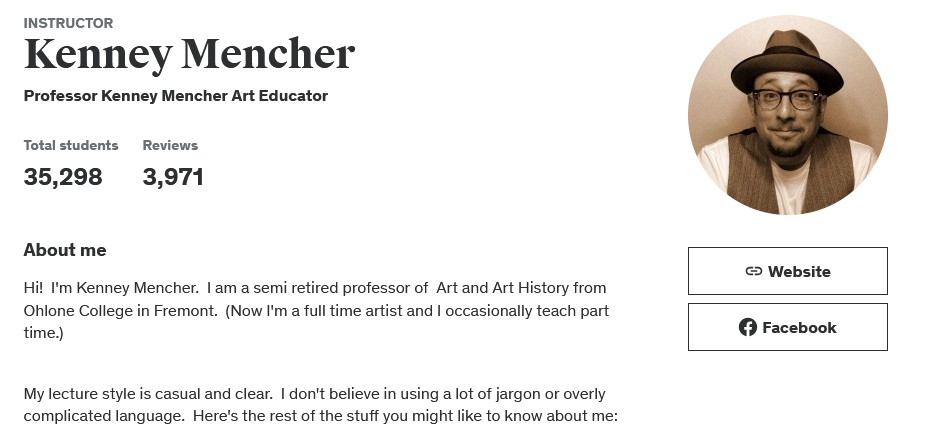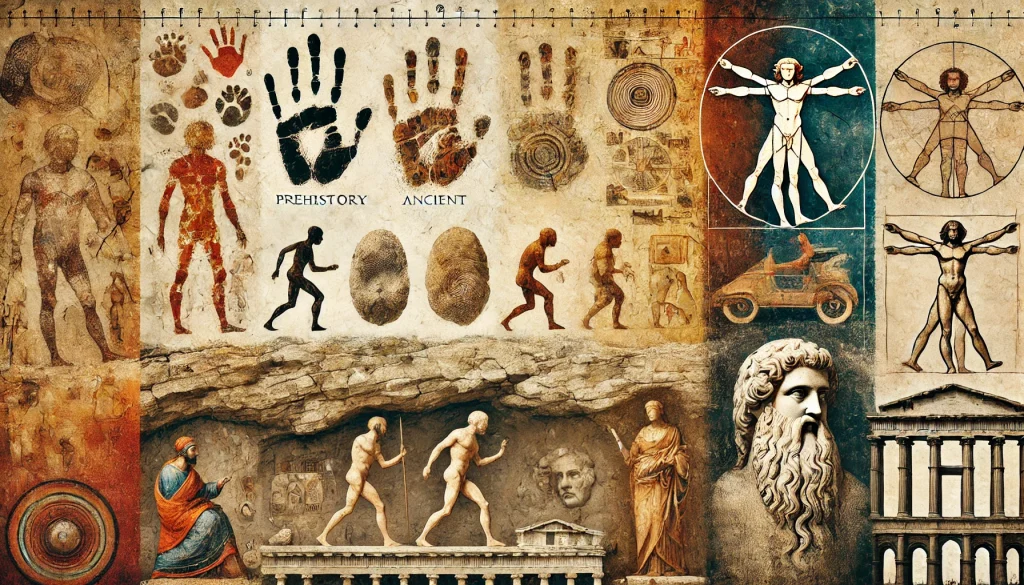The Art History Prehistory to the Renaissance course on Udemy promises to take you on a journey through time, from ancient cave paintings to the early Renaissance. It’s part of a year-long college-level survey, which gives it a hefty academic punch. But don’t worry—this isn’t your typical dry lecture series. Kenney Mencher, the instructor, makes the material accessible and engaging without overwhelming you with jargon.
Instructor Reputation
Kenney Mencher brings a wealth of experience to the Art History Prehistory to the Renaissance course. His teaching career spans decades, most notably as a full-time professor at Ohlone College, a position he held for over 15 years. During his time in academia, he developed and refined his teaching methods, which are reflected in the clear and structured delivery of this course. Mencher isn’t just an academic, though—he’s also a practicing artist with exhibitions across the United States, including solo shows in places like San Francisco, Sacramento, and Dallas. This dual experience in both teaching and practicing art adds a unique dimension to his lectures.

His academic background includes degrees in both studio art and art history from respected institutions like the University of California, Davis, and the University of Cincinnati, where he also earned an MFA in Painting. His MA thesis, intriguingly titled “Vampires, the Audiences They Consume,” hints at his ability to approach topics from unconventional and engaging angles. This diverse background enriches his teaching by blending formal art analysis with cultural narratives that are easy to follow.
What makes Mencher stand out from other online instructors is his accessible and down-to-earth teaching style. While many art history courses can feel intimidating or weighed down by complex terminology, Mencher’s approach is intentionally jargon-free. His goal is to ensure that every student, regardless of prior art knowledge, can follow along and feel confident discussing art. He even mentions that part of his motivation for the course is to help learners impress their friends or partners during a gallery visit—an endearing, human touch.
On Udemy, Mencher maintains an impressive 4.6 instructor rating across nearly 4,000 reviews. His courses have drawn more than 35,000 students, and his reputation as both an educator and artist adds credibility to this offering. Students consistently praise his clear explanations, structured content, and enthusiasm for the subject. He also has a knack for making art history enjoyable rather than overwhelming, which is no small feat given the vast amount of material the course covers.
In short, Mencher’s reputation as an educator and artist is well-earned. His years of teaching at various institutions, from high schools to universities, combined with his extensive artistic practice, ensure that students are learning from someone who has both academic rigor and practical insight. Whether you’re preparing for a college course or just exploring art history for personal enrichment, you can trust that you’re in good hands with Mencher.
Course Structure
The Art History Prehistory to the Renaissance course is laid out in a way that makes it both comprehensive and easy to follow, even for students who might be new to art history. The course takes students on a chronological journey, starting with prehistoric cave paintings and progressing through various ancient, classical, and medieval art movements, finally arriving at the early Renaissance. What sets this course apart is its breadth—it doesn’t just focus on Western art but also covers ancient non-Western traditions, including the art and architecture of Asia, Africa, and the Americas. This provides students with a holistic view of how different cultures have expressed themselves through art over the centuries.

The course is organized into a series of video lectures, with each section focusing on a particular era or theme in art history. Mencher carefully explains the stylistic elements, materials, and techniques used to create significant works of art from each period. For example, when discussing ancient Greek sculptures, he breaks down concepts like contrapposto (a naturalistic stance in sculpture) and explains how the materials used—like bronze or marble—contributed to the aesthetic and symbolic goals of the artists. Similarly, the course dives into the symbolism of religious art in medieval Europe, unpacking the layers of meaning hidden in seemingly simple visual motifs.
Mencher also emphasizes the technical aspects of art creation, such as the materials and processes involved. Students will learn about the pigments used in Renaissance paintings, the role of architecture in ancient civilizations, and how artists across cultures and time periods have solved similar technical challenges in different ways. The lectures are supplemented with study guides, worksheets, and an online textbook, making it easier for students to absorb and retain the information. These resources are particularly useful for anyone preparing for exams in a college-level art history course or trying to pass the AP Art History exam.
One of the course’s strengths is the way Mencher integrates cultural context into his lessons. For instance, he doesn’t just describe a piece of art—he explains what it meant to the people who created it and how it functioned within their society. Whether it’s understanding the religious significance of African masks or the political symbolism in Renaissance frescoes, students gain insight into how art reflects the values and concerns of different cultures.
Another noteworthy feature of the course is how it balances depth with accessibility. Mencher’s lectures are thorough without feeling overwhelming. He takes the time to discuss individual artworks in detail, covering their composition, shading, and materials, but always ties these elements back to larger cultural and historical narratives. This ensures that students not only learn the technical language of art history but also develop the ability to interpret art in a meaningful way.
The only downside reported by some students is the repetition of certain lectures. Because this course is part of a larger series, a few lectures are repeated across multiple courses, which can feel redundant if you’re taking more than one of Mencher’s art history classes. However, for those focused on this single course, the repetition is minimal and doesn’t detract from the overall quality of the content.
In summary, the course structure is well thought out and designed to suit both casual learners and serious students. Whether you’re preparing for a college art history class or just want to explore the subject for fun, the clear organization and engaging delivery make this course an excellent choice. With Mencher’s guidance, students will gain both the knowledge and the confidence to discuss art intelligently, whether in a classroom or at a museum.
Content Quality
The content in Art History Prehistory to the Renaissance is impressively robust and thoughtfully crafted, making it feel like an authentic college-level course without the intimidating academic pressure. What sets the course apart is the amount of depth it offers. Kenney Mencher doesn’t just skim over famous artworks; instead, he dives into the technical, historical, and symbolic aspects of each piece, giving students a well-rounded understanding of its significance. Whether he’s discussing the brushstrokes of a Renaissance painting or the symbolism in African sculptures, the explanations are clear and engaging.

One of the course’s strongest aspects is how it brings art history to life by exploring works from both Western and non-Western cultures. For example, students learn not only about Michelangelo and Leonardo da Vinci but also about ancient art from Asia, Africa, and Mesoamerica. This approach ensures a more global perspective on art, making it an ideal choice for students who want to go beyond the typical European art history narrative. Mencher’s thoughtful inclusion of non-Western works helps learners appreciate the diversity of human creativity across time and cultures.
Each lecture offers a blend of art theory and practical analysis. Students are introduced to the formal elements of art, such as composition, color, materials, and shading. Mencher also goes deeper into the significance of these elements by discussing how they contribute to a piece’s meaning and how viewers can interpret symbols within a larger cultural framework. These insights not only enhance the learner’s understanding of individual works but also equip them with the skills to analyze and appreciate art in any setting, whether it’s a museum visit or a classroom discussion.
The course offers excellent supplementary resources to enhance the learning experience. Mencher provides study guides, worksheets, and an online textbook, ensuring students have the tools they need to succeed. The materials are organized in a way that encourages self-paced learning, making the course accessible to people with varying schedules and commitments. These additional resources are especially helpful for those preparing for college exams or AP Art History tests, as they reinforce key concepts covered in the lectures.
Another standout feature is Mencher’s delivery. His lectures are concise yet detailed, striking a perfect balance between thoroughness and accessibility. Even students with little to no background in art history will find the material easy to follow, thanks to his clear explanations and engaging style. He avoids academic jargon, focusing instead on making the content approachable and enjoyable. This makes the course a great option for anyone looking to gain practical knowledge about art without feeling overwhelmed by technical language.
That said, the course isn’t entirely without its flaws. A few students have noted the occasional repetition of content, which can be a bit frustrating for those who have taken other courses in Mencher’s series. However, these instances are rare and don’t significantly detract from the overall learning experience. For most students, the depth and quality of the content far outweigh this minor inconvenience.
In summary, the content quality of this course is exceptional. It offers a deep, insightful, and accessible exploration of art history, supported by a range of supplementary materials that enhance the learning process. Whether you’re looking to pass a college course, prepare for an exam, or simply enrich your understanding of art, this course provides everything you need in a well-organized and engaging package.
Overall Course Rating – 9/10
After going through the lectures, studying the materials, and engaging with the content, it’s clear that Art History Prehistory to the Renaissance is one of the better online art history courses available today. On a scale of 1 to 10, this course earns a solid 9/10. It offers a near-perfect blend of academic rigor, engaging delivery, and accessibility, making it suitable for both casual learners and serious students. The course provides exceptional value with its global art coverage, detailed lectures, and ample supplementary resources.

One of the course’s standout features is how effectively it delivers college-level content in a way that feels approachable. Many online courses struggle to strike the right balance between being too basic or too advanced, but Mencher navigates this perfectly. His use of clear, jargon-free language makes art history accessible to beginners, while the depth of his analysis ensures that even more advanced learners will walk away with new insights.
The course structure is another strength. The chronological organization helps students follow the evolution of artistic styles and cultural shifts over time, giving them a sense of how art reflects societal values. The inclusion of both Western and non-Western art broadens students’ perspectives, exposing them to artistic traditions they might not encounter in a typical classroom setting. This global approach is essential for anyone interested in developing a comprehensive understanding of art history.
The course’s only notable drawback is the occasional repetition of content, which has been mentioned in some student reviews. While this issue is relatively minor, it can be slightly annoying for learners who are taking multiple courses in Mencher’s series. That said, the repetition is minimal and doesn’t significantly affect the overall experience or the course’s educational value.
In terms of accessibility, the course is ideal for students who need flexibility. Its self-paced structure allows learners to engage with the material on their own time, making it a great fit for those with busy schedules. Additionally, the online textbook, worksheets, and study guides provide multiple ways to interact with the content, ensuring that different learning styles are accommodated.
Ultimately, Art History Prehistory to the Renaissance is a well-rounded and thoughtfully designed course that offers a rich educational experience. Whether you’re pursuing art history academically or just want to expand your knowledge for personal enrichment, this course will leave you better equipped to understand, analyze, and appreciate art. The combination of Mencher’s engaging teaching style, comprehensive content, and accessible structure makes this course a must-try for anyone with an interest in art history.



